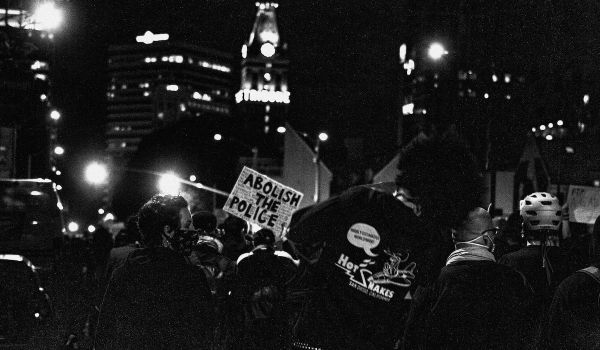Last week, in Washington DC, the Robert Wood Johnson Foundation and Transportation for America held a roundtable discussion called “Keeping Kids Moving”, which examined how federal transportation policy can help keep children safer and healthier, and help achieve Michelle Obama’s ambitious goal of ending childhood obesity in one generation.
In a recent blog post, Ray LaHood acknowledged the connection between transportation policy and the obesity epidemic. Transportation policy is “not just about improving sidewalks or bike paths,” wrote LaHood. “The assumption of the last half of the 20th century was that people would own cars. And because that isn’t true, people have been forced to make choices that contribute to the obesity trend.” And LaHood acknowledges that it’s not just the lack of physical activity that leads to obesity in America, it’s also the secondary effects of our auto-centric transportation policy. He cites Nashville’s Director of Healthy Living Initiatives, Adetokunbo Omishakin, who spoke about the thousands of households in Nashville who don’t own a car, and live more than one mile from a real grocery store. They have to rely on neighborhood corner stores for food — most of which is processed, sodium-laden garbage — to feed their families. Nashville is one of the country’s fatter metros, with 28.4% of its population obese, meaning that roughly one in three people in the Nashville metro area is overweight to the point that it will affect their health.
Something tells me that, while the US DOT’s eagerness to tackle this issue by offering better options for Americans is certainly well-intentioned, transportation policy most likely affects obesity rates less than we in the urban planning world would like to think. Take, for example, this Gallup report from last year. Titled “Good Health Habits the Norm in Slimmest U.S. Metro Areas”, the report lists our metro areas from slimmest to fattest. The metros with low rates of obesity are not necessarily powerhouses of innovative transportation policy. The top two, Fort Collins and Boulder, CO, are college towns that are both walkable and bikeable. No surprise there. Same goes for San Francisco and Denver, numbers 9th and 10th, respectively. But seeing Colorado Springs (4th), Reno (6th) and San Jose (8th) on the top ten thinnest cities is a bit surprising. When we think of transit access and walkability, I guarantee you those cities don’t come to mind.
The average obesity rates for metros is 26.5%, according to Gallup. Here’s a list of metros that, if you believe walkability and transit access are useful tools for combating obesity, you might be surprised to find clock in at average or above-average obesity rates: Philadelphia (26%); Cincinnati (26.2%); New Orleans (26.4%); Pittsburgh (26.9%); St. Louis (27%); Baltimore (28%). All the way at the bottom was Montgomery, AL at 34.6% obese. Montgomery, too, is an older city that ought to be walkable, and it has one of the most infamous public transit systems in the nation.
It is certainly difficult to calculate metrics like transit access and walkability, but harder than that would be to correlate those metrics with obesity rates. Some of our oldest, densest cities — the cities that planners most like to emulate — suffer from epidemic level obesity rates. And some of our more sprawling metros are much fitter and healthier. Because this DOT initiative has to do with childhood obesity rates, it’s worth pointing out that the same trend is true for children, according to this 2007 study; the highest rate of childhood obesity is in the nation’s capital, an astonishing 23%, and the lowest rate is in the state of Wisconsin, with 9%. The lower end of that graph is filled with states like Idaho, Colorado, Utah, and Minnesota. Again, they’re hardly the states we think of when we think transit equity and walkability.
Really, it is much easier to correlate obesity rates with poverty than it is with walkability or livability. That isn’t to say that the US DOT shouldn’t be working on increasing our transit and livability options, it’s just to say that no one should be surprised if these initiatives fail to provide any meaningful decreases in the obesity rate.
More likely than anything else is that our reliance on ADM, Cargill, and Tyson to make virtually all of our food has much worse affects on our bodies than whether we can walk to a bus stop or not. Beyond that, the fact that we have exported most of our high-paying manufacturing jobs overseas, and import most of our cheap labor for agricultural work has left a whole lot more Americans in poverty, without health insurance (it seems worth pointing out here that these are very physically demanding jobs that we’ve gotten rid of — no cubicles here). As a nation, we can’t afford good food or a doctor to let us know when we’re slipping towards obesity. Virtually all of us are forced to eat corn-derivative mass-produced food or almost nothing at all. Better bike paths will not make a pound of 70/30 ground chuck any more expensive, healthier, or less ridden with dangerous microbes.
Our national obesity epidemic is an excellent example of where three decades of corporate deregulation has taken us. People can’t find decent work, so they can’t afford decent food, and all the food in the supermarket is processed and raised in unhealthy ways by the large corporations that have bought up the family farms that used to dot the country from the Ohio to the Plains. Any meaningful federal effort to combat the obesity epidemic will have to take on these corporations, and beyond that, attempt to change Americans’ eating habits. I went to a Denny’s for the first time in years recently and I can honestly say I don’t know which will prove more difficult (their menu is separated by the manner in which you get the food from the plate, into your mouth! — Fork & Knife, Handheld, and so on). But discretionary US DOT funding might not be the answer we want it to be; it’s too easy.
And, as we all know, the US DOT ought to be spending money on livability anyway. It’s long overdue, and they don’t need a flimsy defense like combating obesity to justify it.

_600_350_80_s_c1.jpg)













